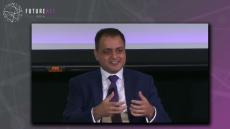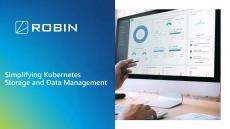|
By Haridev Cheviry
Now that we have discussed the networking part , the next step is placing the application into a host. Robin.io’s cloud platform has the concept of master, compute, and storage nodes. Typically, the hardware servers would have multiple NUMA nodes. In order to achieve the best performance, the platform should utilize the resources from the same NUMA node. Failing this – if users are consuming a resource from another NUMA node – then their performance would degrade.
Demystifying the complexity of cloud-native 5G network functions deployment using Robin CNP - Part I
|
By Haridev Cheviry
Robin.io simplifies the operations and lifecycle management of 5G applications at scale and demystifies the complexity around 5G and network functions management. The simplified end-to-end automation and App-Store-like user interface makes the management of applications easy for operators. This is relevant for several reasons.
|
By Robin
2022 has been a phenomenal year for Robin.io. We had some big-ticket moments at the Mobile World Congress Barcelona; we became a part of the prestigious Rakuten group, and now, we are continuing the sprint, having been named Leader and Outperformer by the 2022 GigaOm Radar Report for Mobile Edge Solutions.
|
By Mehran Hadipour
The biggest question facing many businesses today is how to improve the efficiency and agility of their application delivery processes. Along the journey to infrastructure modernization, do they continue to maintain applications as-is, or do they need to be migrated, upgraded or replaced? This blog attempts to answer some of these questions. Take any popular enterprise app, like your Oracle business suite, or even a custom-built application, and it will typically follow a three-tier architecture.
5G is seeing rapid adoption due to its promise of high speed, seamless delivery and low latency, that enables it to deliver new and exciting revenue-generating services. Studies reveal that there will be 1.2 billion 5G connections by 2025, covering a third of the world’s population. 5G will play a critical role in enabling the next-generation of applications and services, like gaming, trade and Industry 4.0, in general.
The Multi-access Edge Compute (MEC) framework enables mobile operators, application developers, and content providers to deploy predictable cloud-computing capabilities at the network’s edge and in the immediate proximity of mobile networks.
The Multi-access Edge Compute (MEC) framework enables mobile operators, application developers, and content providers to deploy predictable cloud-computing capabilities at the network’s edge and in the immediate proximity of mobile networks.
|
By Partha Seetala
It’s never too early or late to start talking about cloud-native. By 2025, more than 95% of new workloads will be deployed on cloud-native platforms. Clearly, a lot of organizations are on their way to cloud-native adoption, among them some of the prominent telecom operators of our time. After all, the benefits of cloud-native are most pronounced in the telecom sector, where the need for scale, automation and predictable cost structure at optimal OPEX and CAPEX is more persistent than ever.
|
By Robin.io
Focused on reliable high performance, cost efficiency, multi-domain automation. Delivering on today's mobile operator needs in the simplest way and preparing for the next generation of 5G and Enterprise cloud-native deployments & operations. Partha Seetala to lead Rakuten Symphony's Unified Cloud business unit.
|
By Dilip Krishna
5G has proven to be a game-changer for several businesses. Given the advancements in O-RAN contributed by cloud-native design & 5G Core, telecommunication vendors, Communication Service Providers (CSPs), and enterprises are trying to deliver an extraordinary customer experience by leveraging 5G. This also presents a massive opportunity for service providers to simplify and enhance customer experience, fortify existing revenue streams, and tap into new markets.
|
By Robin
What does the future of networks look like? The Keynote Fireside chat at Future Net Asia 2022 with Rakuten SVP & Global Head of Telco Cloud Vivek Chadha demystifies the cloud-native paradigm, with discussions on pertinent topics, such as the increased adoption of 5G cloud-native networks; the brand new possibilities that Edge opens up for AI/ML use cases beyond 5G and Open RAN; optimizing control vs costs in public and private cloud set-ups, and more. Featuring moderator Aaron Boasman-Patel, Vice President AI, TM Forum.
|
By Robin
Partha Seetala, President, Cloud BU, Rakuten Symphony, joins a panel of industry experts to discuss how providers can leverage the strengths of cloud-native virtualized ORAN to build next-generation multi-vendor networks.
|
By Robin
Leveraging Kubernetes to modernize application infrastructures presents several opportunities. Learn more about how Kubernetes is offering complete automation with reduced human intervention and shaping a cloud-native future. Executive Speakers: Ravi Alluboyina - Vice President of Engineering, Robin.io, A Rakuten Symphony Company David Lu - VP, Software Defined Networking Platforms and Systems, AT&T
|
By Robin
ROBIN is the industry’s first hyper-converged Kubernetes platform for big data, databases, and AI/ML. The platform provides a self-service App-store experience for the deployment of any application, anywhere – runs on-premises in your private data center or in public-cloud (AWS, Azure, GCP) environments.
|
By Robin
As container and Kubernetes adoption grows, developers and DevOps teams are expanding the use cases beyond stateless applications to stateful applications in order to drive operational consistency, extend the agility of containerization to data, gain faster collaboration, and simplify the delivery of data services. However, when it comes to provisioning storage for complex stateful applications that span multiple pods and services, careful storage management and day-to-day data management capabilities and expertise are critical requirements.
|
By Robin
Operators are waking up to the benefits of cloud-native, which overcomes the fundamental limitations of software-driven virtualization. An opinionated stack, cloud-native forces vendors to build the deployment models of their network functions in a certain way, shifting the power back to the hands of operators. Hear from industry leaders as they reveal groundbreaking insights in this FutureNet World panel discussion in London. Featuring Partha Seetala, President, Cloud BU, Rakuten Symphony.
|
By Robin
Some of the key requirements as operators deploy #telecom data centers include managing their NFs in a cloud-native world to achieve low-latency and high throughput for #5G applications, meeting scalability targets, achieving bare-metal performance without virtualization overheads, and so on. Robin’s #CloudNative Platform solves various challenges associated with #5G CNF deployments, along with delivering the convenience of zero touch automation, multi-cloud portability, and hyperscale orchestration.
|
By Robin
Robin.io was named the winner of the Automation Solution Award at the 2021 FutureNet World Awards. Considering the illustrious group of finalists, the award recognition validates Robin’s efforts to provide operators with software solutions that provision network capacity, automate service delivery and reduce operating costs.
|
By Robin
As we progress further into the next phases of the wireless evolution, we find that enterprises and consumers have an insatiable appetite for speed and new services. They are adopting the current 5th Generation (5G) mobile network as quickly as it becomes available. However, they require use cases with unprecedented mobility, security, low-latency and tighter integration between wireless and mission critical applications.
|
By Robin
As the industry moves to the next phases of the 5G rollout, operators face the need to deliver a greater number of new services, with increased speed, lower latency and strict Quality of Service (QoS), over more endpoints than ever before. Many begin by deploying 5G radio services connected to a 4G Evolved Packet Core (EPC), known as non-standalone (NSA). While NSA can enable higher speed of services, the EPC is not capable of enabling 5G core's (5GC) rich feature set, including QoS-enabled network slices.
|
By Robin
As the industry moves into the next phases of the 5G rollout, operators face the need to deliver a greater number of new services, with increased speed, lower latency and strict Quality of Service (QoS), at higher speeds and over more endpoints than ever before. This is the lynchpin for delivering higher quality, more profitable services. Among the many advantages, 5G's inherent virtualization and cloud-native frameworks set the stage for not only hardware-software disaggregation, but also the disaggregation of vendors, promoting best-of-breed Open RAN (O-RAN).
|
By Robin
Enterprises need high-performance storage for their stateful applications. Their needs vary from running Relational and NoSQL Databases to Big Data to AI/ML workloads. They want near bare metal like performance along with scale. In this white paper, we compare Robin Platform with open source GlusterFS and our analysis show that Robin platform provides near bare-metal performance and could scale well to meet the needs of Big Data and AI/ML applications.
|
By Robin
As more and more enterprises move to Kubernetes for their cloud-native needs, they are looking for high-performance storage options for their stateful and data-intensive workloads. Beyond a seamless workflow to provision storage, they are also looking for complete data lifecycle management features as a part of their storage platform. Robin Storage is a perfect candidate for this need. With their application awareness, high performance and scale, Robin Storage is well suited to meet enterprise cloud-native storage needs.
- October 2022 (4)
- September 2022 (4)
- August 2022 (2)
- July 2022 (3)
- June 2022 (2)
- May 2022 (1)
- February 2022 (4)
- January 2022 (3)
- December 2021 (2)
- November 2021 (7)
- October 2021 (10)
- September 2021 (1)
- July 2021 (1)
- June 2021 (1)
- May 2021 (2)
- April 2021 (9)
- March 2021 (2)
- January 2021 (1)
- December 2020 (5)
- January 2020 (1)
- October 2019 (2)
Hyper-converged cloud-native Kubernetes platform deployed at scale and running some of the most complex data & network intensive (stateful) applications for large enterprises and service providers.
Robin solves the challenges in automating deployment, scaling and lifecycle management of enterprise applications and 5G rollouts using the power of Kubernetes and cloud-native services.
Why customers choose Robin:
- Deploy stateful apps on Kubernetes: Highest performing storage and data management for any Kubernetes on-premises or in any cloud. Automate all aspects of critical day-2 operations to run databases, big data, timeseries and message queue services in production on Kubernetes.
- Deploy 4G/5G RAN and core at scale: Bring cloud agility to deploy 4G and 5G RAN (DU, CU-CP and CU-DP) on COTS hardware in minutes. Enable centralized orchestration of 10s of thousands of cell-sites and base-band units.
- Deploy and manage apps at the edge: Deploy complex storage and network-intensive apps on edge clusters with ease. Enable scalable automation of rollout, upgrade, and auto-heal apps at edge locations.
- Common platform to run containers and VMs: Run containers and virtual machines on Kubernetes directly on bare-metal. Enable consistent and common lifecycle management of containers and virtual machines.
- Common data management platform for hybrid & multi-cloud: Consistent storage experience across different environments. Allow easy migration and portability of apps along with their data across different cloud environments.
- Automate day-2 operations: Bring cloud agility to your bare-metal infrastructure. Centrally manage 10s of thousands of Kubernetes clusters from edge to cloud to private data centers. Create repeatable and robust workflows to automate all network and IT operations.
The most advanced open-source Kubernetes platform optimized for storage and network intensive applications.
















